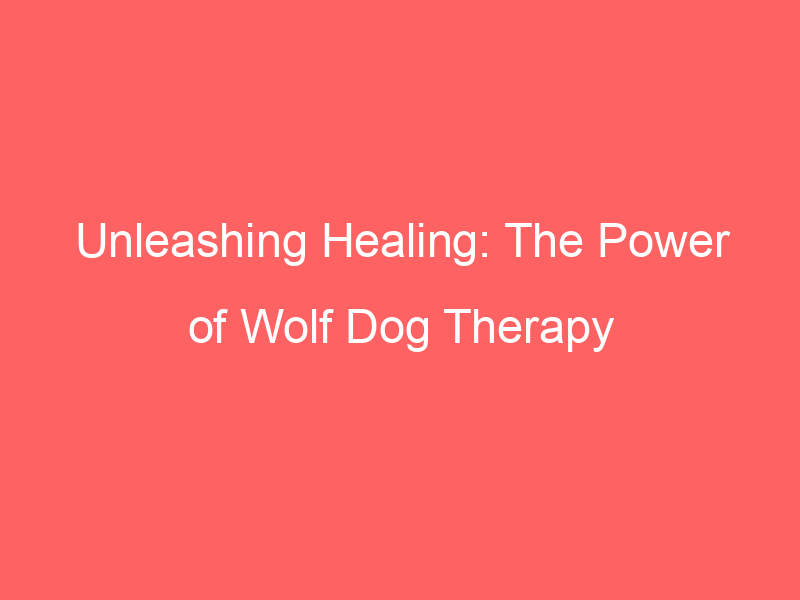Introduction to Wolf Dog Therapy
Wolf Dog Therapy is a fascinating and innovative approach to mental health and wellness. It’s an exciting field that’s gaining recognition and respect worldwide. But what exactly is it, and how does it work? Let’s dive in and explore.
- Overview of Wolf Dog Therapy
- The rise of Animal Assisted Therapy
Wolf Dog Therapy is a type of Animal Assisted Therapy (AAT) that involves interaction with wolf-dog hybrids. These are animals that have both wolf and dog ancestry. They are not pets, but rather, they are trained therapy animals that can provide a unique and powerful form of therapeutic support.
Wolf Dog Therapy can help people of all ages, but it’s particularly effective for children and teenagers. This therapy can assist with a wide range of mental health issues, such as anxiety, depression, PTSD, and behavioral problems. It can also help improve social skills, self-esteem, and overall emotional well-being.
Animal Assisted Therapy, or AAT, has been around for many years, but it’s only recently that it’s started to gain mainstream recognition. This rise in popularity is due to numerous studies showing the positive effects of AAT on mental health.
Animals, including dogs, cats, horses, and even dolphins, have been used in therapy sessions. They provide comfort, reduce stress, and can even help improve physical health. The rise of AAT has paved the way for more specialized forms of therapy, like Wolf Dog Therapy.
In the following sections, we’ll delve deeper into the world of Wolf Dog Therapy. We’ll explore how it compares to traditional therapy dogs, the therapeutic benefits it offers, and how it can help forge a deeper connection between humans and animals. So, stay tuned!
Healing Through Connection: The Wolf Dog Connection
In this section, we delve into the heart of the wolf dog connection and explore how this unique bond can facilitate emotional healing. Let’s take a closer look.
Understanding the Wolf Dog Connection
The wolf dog connection is a unique bond that has been observed between humans and wolf dogs. This bond is not just about companionship, but it also has therapeutic benefits. Let’s explore this in detail.
- The unique bond between humans and wolf dogs
- How wolf dogs facilitate emotional healing
Wolf dogs are known for their loyalty, intelligence, and ability to form deep connections with humans. This bond is unique because it is built on mutual respect and understanding. Wolf dogs are not just pets, they are companions who can understand human emotions and respond to them. This understanding forms the basis of the therapeutic benefits of the wolf dog connection.
Wolf dogs have a natural ability to sense human emotions and respond in a comforting manner. This can have a profound impact on individuals dealing with emotional distress. The presence of a wolf dog can provide a sense of calm and security, helping individuals to open up and express their feelings. This process can facilitate emotional healing. For example, a study conducted in 2018 found that interaction with wolf dogs led to a significant reduction in stress and anxiety levels among participants.
In conclusion, the wolf dog connection is a powerful tool for emotional healing. It leverages the unique bond between humans and wolf dogs to provide comfort and support. This connection is not just about companionship, it’s about healing and growth.
Case Study: Healing with Wolf Dogs
Wolf dogs have been known to provide a unique form of therapy that has helped many individuals heal emotionally. Let’s delve into some personal experiences and scientific studies that highlight the therapeutic benefits of wolf dogs.
- Individual Experiences of Healing through Wolf Dog Therapy
- Scientific Studies Supporting the Therapeutic Benefits of Wolf Dogs
One such story is of a young boy named Timmy. Timmy, who had been dealing with severe anxiety, found a friend and a healer in a wolf dog named Max. Max’s calm demeanor and intuitive understanding of Timmy’s feelings helped him navigate his anxiety and build his self-confidence. Over time, Timmy’s anxiety levels reduced significantly, and he was able to engage more confidently in social situations.
Another inspiring story is of a war veteran named John. John was struggling with post-traumatic stress disorder (PTSD) after returning from service. His life took a turn for the better when he met Bella, a wolf dog. Bella’s presence provided John with a sense of calm and security. He found comfort in Bella’s companionship, which helped him manage his PTSD symptoms more effectively.
Research has also backed up these individual experiences. A study conducted by the University of California found that interaction with wolf dogs led to a noticeable decrease in stress and anxiety levels among participants. The participants reported feeling more relaxed and at ease after spending time with the wolf dogs.
Another study from the Canine Therapy Research Center showed that wolf dogs could help improve the mental health of individuals dealing with depression. The study found that the participants who interacted with wolf dogs showed a significant improvement in their mood and overall mental well-being.
In conclusion, both personal experiences and scientific research highlight the therapeutic potential of wolf dogs. Their intuitive understanding of human emotions and calming presence can provide comfort and healing to those in need.
Therapy Dogs Vs Wolf Dogs: A Comparative Analysis
In this section, we will delve into a comparative analysis of therapy dogs and wolf dogs. We will start by understanding therapy dogs, their roles in healing, and their benefits and limitations.
Understanding Therapy Dogs
Therapy dogs are special dogs trained to provide comfort, affection, and companionship to people. They are often used in hospitals, nursing homes, schools, and disaster areas to help reduce stress and improve mood.
- Role of therapy dogs in healing: Therapy dogs play a significant role in the healing process. They can help lower blood pressure, decrease feelings of loneliness, and increase social interaction. For example, a study conducted in 2019 showed that therapy dogs helped reduce anxiety in children undergoing dental procedures.
- Benefits and limitations of therapy dogs: Therapy dogs offer numerous benefits. They can help improve mental health, reduce stress, and even improve physical health. However, they also have limitations. Not everyone is comfortable around dogs, and some people may have allergies. Additionally, therapy dogs require regular care and training to maintain their effectiveness.
In the next section, we will look at wolf dogs and compare their therapeutic benefits and limitations with those of therapy dogs.
Understanding Wolf Dogs
Wolf dogs, as the name suggests, are a unique blend of domestic dog and wild wolf. They are known for their intelligence, strength, and loyalty, but how do they contribute to healing? Let’s explore.
- Role of Wolf Dogs in Healing
Wolf dogs have a unique ability to connect with humans on a deep emotional level. This connection can be therapeutic and healing for individuals dealing with various mental and emotional challenges. For instance, interacting with a wolf dog can help reduce stress and anxiety, improve mood, and promote a sense of well-being.
Wolf dogs are also known for their intuitive nature. They can sense human emotions and respond in a way that provides comfort and support. This makes them excellent companions for those dealing with trauma or grief. Their presence alone can provide a sense of calm and security.
- Benefits and Limitations of Wolf Dogs
Wolf dogs offer numerous benefits as therapeutic companions. Their intelligence and intuitive nature make them excellent at understanding and responding to human emotions. They can provide comfort, reduce stress, and promote a sense of well-being. Their loyalty and protective nature also make them excellent companions.
However, wolf dogs also have their limitations. They require a lot of exercise and mental stimulation due to their high energy levels and intelligence. They also require a strong, experienced handler who can provide the necessary training and socialization. Wolf dogs are not suitable for everyone and should only be considered by those who can meet their specific needs.
In conclusion, wolf dogs can play a significant role in healing and therapy. However, they require a dedicated and experienced handler to ensure their needs are met and their potential as therapeutic companions is fully realized.
Canine Therapy: The Therapeutic Benefits of Wolf Dogs
Wolf dogs, a unique blend of domestic dog and wild wolf, have been found to offer a range of therapeutic benefits. In this section, we will explore the physical health benefits of wolf dogs in the realm of canine therapy.
Physical Health Benefits
Wolf dogs can contribute significantly to our physical health in several ways. Let’s delve into how they do this and provide some examples of physical health improvements.
- How Wolf Dogs Contribute to Physical Health
- Examples of Physical Health Improvements
Wolf dogs, like other dogs, encourage physical activity. Their need for exercise can help their human companions stay active, which is essential for maintaining good health. Regular walks and playtime with a wolf dog can help improve cardiovascular health, lower blood pressure, and maintain a healthy weight.
Additionally, the act of petting a wolf dog has been found to release endorphins in the human brain, which can help reduce pain and induce a state of calm. This can be particularly beneficial for those dealing with chronic pain or recovering from surgery.
There are numerous examples of wolf dogs contributing to physical health improvements. For instance, a study found that heart attack patients who owned dogs, including wolf dogs, lived longer than those who didn’t. This is likely due to the increased physical activity and stress relief that comes with owning a pet.
Another example is the role of wolf dogs in physical rehabilitation. Their need for exercise can motivate individuals recovering from physical injuries or surgeries to get moving, which can speed up their recovery process.
In conclusion, wolf dogs can offer substantial physical health benefits, from promoting regular exercise to providing pain relief and aiding in physical rehabilitation. Their unique blend of domestic and wild traits make them an excellent choice for those seeking the therapeutic benefits of canine therapy.
Mental Health Benefits
Wolf dogs, like other therapy animals, provide significant mental health benefits. Let’s dive deeper into how these unique creatures contribute to mental wellbeing and explore some examples of mental health improvements.
- How Wolf Dogs Contribute to Mental Health
- Examples of Mental Health Improvements
Wolf dogs have a unique ability to sense human emotions, which makes them excellent companions for those struggling with mental health issues. Their intuitive nature allows them to provide comfort and companionship, reducing feelings of loneliness and isolation. They can help lower stress levels, improve mood, and even boost self-esteem.
Interacting with a wolf dog can stimulate the release of endorphins, the body’s natural mood elevators. This can be particularly beneficial for individuals suffering from depression or anxiety. Moreover, the responsibility of caring for a wolf dog can provide a sense of purpose and routine, which is often beneficial for mental health.
There are numerous examples of how interaction with wolf dogs has led to significant mental health improvements. For instance, individuals with post-traumatic stress disorder (PTSD) have reported a decrease in symptoms after spending time with these animals. They have found comfort and solace in the company of wolf dogs, which has helped them cope with their trauma.
Children with autism, too, have shown remarkable improvements in their social skills and anxiety levels after interacting with wolf dogs. The animals’ calm demeanor and non-judgmental nature make them ideal companions for these children, helping them feel more comfortable and confident in social situations.
Moreover, seniors suffering from dementia have also benefited from wolf dog therapy. Interaction with these animals has been found to reduce agitation and improve mood among these individuals, enhancing their overall quality of life.
In conclusion, wolf dogs can play a crucial role in improving mental health. Their intuitive nature, combined with their calm demeanor, makes them excellent therapy animals. Whether it’s reducing stress, improving mood, or helping cope with trauma, the mental health benefits of wolf dogs are truly remarkable.
Wolf Dog Therapeutic Connection: A Deeper Look
Wolf dogs, a unique blend of domestic dog and wild wolf, have a special place in the world of therapy. Their unique characteristics and behaviors can form a deep bond with humans, leading to significant therapeutic benefits. But what’s the science behind this connection? Let’s delve deeper into the biological and psychological factors that contribute to this bond.
The Science Behind the Connection
Understanding the wolf dog-human bond requires a look at both biological and psychological factors. These factors work together to create a connection that can be incredibly beneficial for therapeutic purposes.
- Biological factors contributing to the wolf dog-human bond
- Psychological factors contributing to the wolf dog-human bond
Biologically, wolf dogs share a significant amount of DNA with humans. This shared genetic material can lead to a deep understanding and connection between the two species. Furthermore, wolf dogs, like all dogs, have evolved to be highly attuned to human emotions and body language. This ability allows them to respond to human needs in a way that can be very therapeutic.
Psychologically, the bond between a human and a wolf dog can be very powerful. The presence of a wolf dog can provide a sense of comfort and security, reducing feelings of anxiety and stress. Moreover, caring for a wolf dog can give a person a sense of purpose and responsibility, which can be beneficial for mental health.
In conclusion, the wolf dog-human bond is a complex interplay of biological and psychological factors. This bond can be harnessed for therapeutic purposes, providing significant benefits for those in need. The unique characteristics of wolf dogs make them a valuable asset in the realm of therapy.
Impact of the Connection on Healing
Understanding the healing power of the wolf dog-human connection is a fascinating journey. Let’s delve into how this unique bond facilitates healing and explore some real-life examples.
- How the wolf dog-human connection facilitates healing
- Real-life examples of healing through the wolf dog-human connection
Wolf dogs, with their keen senses and intuitive nature, have a unique ability to connect with humans on a deep level. This connection can facilitate healing in various ways. For instance, the simple act of petting a wolf dog can lower blood pressure and heart rate, reducing stress and anxiety. This is due to the release of oxytocin, a hormone that promotes feelings of happiness and relaxation.
Moreover, wolf dogs can provide emotional support and companionship, helping individuals cope with loneliness and depression. Their high energy levels and need for regular exercise can also encourage physical activity, which is beneficial for overall health.
There are numerous inspiring stories of healing through the wolf dog-human connection. Let’s look at a few examples.
One such story is of a young boy named Timmy. Timmy was struggling with severe anxiety and had difficulty interacting with his peers. His family decided to adopt a wolf dog named Max. With Max’s companionship, Timmy gradually became more confident and outgoing. His anxiety levels dropped significantly, and he was able to make friends and participate in social activities.
Another example is of a war veteran named John. John was suffering from post-traumatic stress disorder (PTSD) after returning from deployment. He found solace in the companionship of a wolf dog named Luna. Luna’s presence helped John manage his PTSD symptoms and regain a sense of normalcy in his life.
These examples highlight the profound impact the wolf dog-human connection can have on healing. Whether it’s reducing anxiety, combating loneliness, or aiding in the recovery from traumatic experiences, the therapeutic benefits of this unique bond are truly remarkable.
Conclusion: Unleashing the Power of Wolf Dog Therapy
In this article, we have explored the fascinating world of wolf dog therapy, a unique approach that combines the natural instincts of wolves and the domesticity of dogs to provide therapeutic benefits. Let’s take a moment to recap the benefits and look at the future prospects of this innovative therapy.
- Recap of the benefits of wolf dog therapy
- Future prospects of wolf dog therapy
Wolf dog therapy has shown remarkable results in various therapeutic areas. The unique bond between humans and these majestic creatures has proven to be a powerful tool in healing and recovery. We have seen how wolf dogs can help reduce stress and anxiety, improve mood, and even assist in physical rehabilitation. Case studies have shown that the presence of a wolf dog can significantly increase the effectiveness of therapy sessions, making them a valuable addition to traditional therapeutic methods.
As we look to the future, the prospects for wolf dog therapy are bright. More and more therapy centers are recognizing the benefits of this approach and are incorporating wolf dogs into their programs. Research is ongoing, and we can expect to see more evidence of the effectiveness of wolf dog therapy in the coming years. As we continue to explore and understand the unique bond between humans and wolf dogs, we can only expect this therapeutic method to grow and evolve.
As we conclude, let us remember the words of the famous American author, Mark Twain, who said, “The more I learn about people, the more I like my dog.” Perhaps, in the case of wolf dog therapy, we can modify this quote to say, “The more I learn about wolf dogs, the more I appreciate their therapeutic power.”








